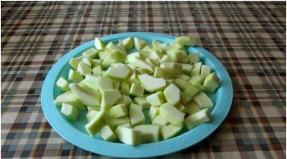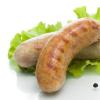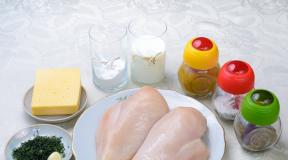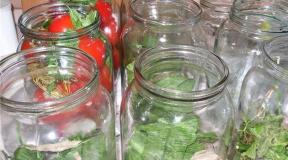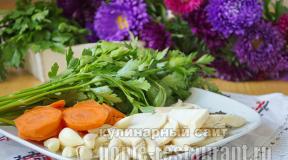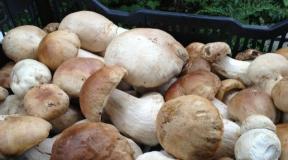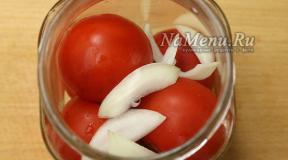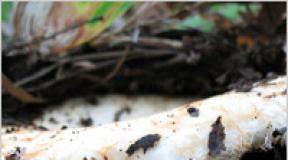Private business in the manufacture of sauces. Sauce production
The consumption of ketchup, mustard and mayonnaise exceeds three kilograms per person per year, so pasty sauces and seasonings will always be in demand.
Food business organization
It is necessary to register an LLC of the future mini-factory and decide on strategic partners involved in the sale of products (wholesale warehouses, bases). Supermarkets are especially important, they prefer to do business with reliable manufacturers, because they provide maximum sales.
Study of regulations and state standards GOST 9159-71, GOST R 53590-2009 and GOST R 52141-2003.
A room is selected that meets sanitary and hygienic standards and a technological line for the production of pasty products is purchased.
A business plan is being formed (which must include the daily output, all costs and net profit). Return on sales is key and should be over 55% for payback in a year.
To confirm the quality of any type of pasty products, certification is required with the appropriate package of documents, according to which the products will be manufactured. These can be GOSTs (Extra category without artificial preservatives) or branded specifications(TU) for other categories.
mayonnaise manufacturing technology
The composition of mayonnaise is not regulated by GOST. The main ingredients are vegetable oil (more than 30%), eggs, sugar (xylitol), salt, milk. It is necessary to have three vats in the workshop (for liquid eggs, butter and paste).
Eggs are pasteurized, pumped into a cooling tank. Then soybean oil is added and diluted in apple cider vinegar spices. The unit mixes the mixture at room temperature for six minutes until smooth and mayonnaise paste is obtained.
After selective laboratory quality control of mayonnaise in terms of color, smell, viscosity and other parameters, it is poured by a dispenser into packaging containers (disposable double-layer bags, plastic).
ketchup technology
Tomato paste is diluted with water, mixed in a digester with sugar (sorbitol), salt, fruit puree, starch, stabilizers, dye. Before pouring into jars, bags and plastic cups, a laboratory test is carried out with a refractometer for the mass content of dry substances of tomatoes and for other parameters (aroma, consistency). Hot pouring (80 degrees) ensures optimum quality.
Mustard production
Crushed seeds (17%) are added to a mixture of pepper, turmeric, salt, vinegar, water (up to 60%) and mixed for about an hour before breaking the grains. The mass is poured into a stone mill with adjustable grinding, where the grains are ground with stones to a cream at a temperature of 60 degrees. Seasoning parameters are checked and poured into jars.
Grain mustard differs from powder seasoning in sweetness, and in french mustard acid is replaced with grape juice.
Five people are enough to service the ketchup, mayonnaise and mustard production line. To stimulate the pace of sales, it is recommended to give discounts to wholesalers and supplement products with promotional booklets, to hold discount sales promotions.
Working directly with supermarkets brings the most bang for your buck, and the quality of the product will work for itself. Sales of full-fat mayonnaise far outpace low-calorie mayonnaise because consumers care about quality, not price. And if we take into account that the market is not yet saturated with pasty products (the growth trend is more than 2%), then the production of ketchup, mustard and mayonnaise guarantees a stable profit.
In this article:
The production of mayonnaise and ketchup is considered to be one of the most profitable. The production of mustard is slightly inferior in economic efficiency, so it is recommended to consider it as an auxiliary product. There is an increased interest of the population in small-scale production, which differs from the standards of mass production. Such a trend can serve a budding entrepreneur in good stead.
On average, the population consumes about 3.5 kilograms of spreadable products per year (mayonnaise, mustard and ketchup). Thus, the product will be in demand, and its production will be economically profitable.
Organizational nuances of the food business
1. Decide on the organizational form of management
For the functioning of a mini-factory for the production of pasty products, it is recommended to register an LLC on the general taxation system. Strategic partners are wholesale depots, food warehouses and supermarkets, which often prefer to cooperate with a reliable company.
For the preparation of periodic reporting, it would be more cost-effective to use the services of an outsourcing company.
During the registration process, a novice entrepreneur will need the following OKVED code: 15.87 Production of spices and seasonings
2. We study regulations
Before the release of the first batch of pasty products, it is recommended to study the state standards:
- GOST R 53590-2009 Mayonnaises and mayonnaise sauces. General specifications.
- GOST R 52141-2003 Ketchups. General specifications.
- GOST 9159-71 Mustard seeds.
3. Product certification
To organize the production of any kind of sauce in without fail you should pass certification and get your hands on the necessary package of documents that will confirm the quality of the product.
The above-mentioned GOSTs or personally developed specifications (technical specifications) can act as regulatory documents.

Mayonnaise production technology
Exist various recipes mayonnaise, but the main ingredients in it are unchanged - eggs and vegetable (soybean) oil. From eggs, only yolks are taken, only whites, or both. Eggs must be pasteurized to kill salmonella and other bacteria. Eggs are brought to large enterprises in metal tanks in liquid form.

With the help of a pump, the eggs are pumped through a hose into a cooling receiving tank.

The second main ingredient is soybean oil. All tanks or other containers that come from the supplier must be hermetically sealed and not opened until arrival at the mini-factory. The pump also pumps oil to storage tanks. Next comes the weighing of additional ingredients - spices, which must be added according to secret recipe companies.


The resulting mixture is poured into a tank room temperature. As a result of mixing all the components, mayonnaise paste is obtained.

Meanwhile raw eggs poured into a large refrigerated tank. Thus, 3 containers are placed in the production workshop: with pasta, eggs and soybean oil. Further, in a certain ratio (according to the company's recipe), all components are sent to a mixing tank.

After 5 minutes of operation of the unit, eggs, pasta and oil are mixed into a homogeneous mass - mayonnaise.

Periodically, product samples of the mini-factory are sent to the laboratory for quality control.

Laboratory assistants evaluate such parameters as color, consistency and smell. After verification finished product quality, the packaging machine pours it into plastic containers. It is recommended to place a foil inside the lid, which is attached by induction heating. It is she who will protect the mayonnaise from heating, and also testify that the jar was not opened after shipment from the factory.

The quality control laboratory performs another check - the consistency of the product is measured.
Ketchup production technology
The production of ketchup begins by adding a mixture of sugar and salt to a giant cauldron of water. The components are thoroughly mixed.
Factories often use ready-made concentrated tomato paste as the main raw material, which is pumped into a large digester.

Sugar is placed in it saline solution.

digester
In a giant cauldron, the mixture is thoroughly mixed. Steam is supplied between the inner and outer walls of the unit, which does not allow the mass to burn. The agitators are constantly spinning and make the ketchup homogeneous, i.e. mixture is homogenized.

The device of the digester
The finished factory sauce is sent for laboratory testing, where the mass fraction of soluble solids is measured using a refractometer - i.e. find out if there are enough tomatoes in the ketchup.
If all the parameters suit the specialist (consistency, aroma, color, etc.), then the batch is sent in bottles.

Containers can be made in a nearby workshop. PVC granules are taken as a basis, which many plastic products consist of. Next, a dye is added - so the container will acquire a noticeable red color.
The granules are heated and ground in a device that is similar to a meat grinder - an extruder.

Hot red "sausages" are crimped on both sides by the walls of the molds.

Then the syringe injects a portion of air into the plastic blank and the semi-finished product becomes a “pot-bellied” bottle.

It is noteworthy that a standard bottle for ketchup weighs only 42 grams, it goes straight from the conveyor to bottling, barely cooling down.
At the same time, ketchup is poured over hot technology when the temperature of the finished product should not be less than 80 degrees. In this case, the appearance and reproduction of bacteria in the sauce is prevented. Next, the bottles are provided with lids, labels and packaged in boxes.
Technology for the production of mustard from seeds
The initial components for the production of the product are: seeds of the mustard plant, pepper and turmeric, salt, water and white vinegar. The crushed ingredients are poured into a mixing tank with water and vinegar.
Approximate proportions for making yellow mustard are as follows: 60% water, 20% vinegar, 15% seeds and 5% spices.

The mustard seed is added last. A huge rotary mixer mixes all the components for about an hour at a speed that helps to break the grains (up to 265 km / h).

rotary mixer
The contents are poured into a stainless steel mill.
Inside the unit there are 2 artificial stones that grind the grains (millstone grinding). In the process of grinding, the mixture is heated to 60 degrees, as a result of which it turns into a bright yellow mustard of a creamy consistency. Before bottling, the finished product is checked for homogeneity.

If the particles are larger than a quarter of a millimeter, then the millstones are adjusted by specialists to a finer grinding program.
We organize a mini-factory - a list of mandatory steps
The preliminary stage of the release of the first batch of the finished product are:
- selection of premises that meet sanitary and hygienic requirements;
- acquisition production line;
- search for an experienced technologist.
The equipment purchase stage is inextricably linked with the planned production volume. Almost all production lines have a similar configuration. The difference lies in the design of the homogenizer - the apparatus that is responsible for crushing into microscopic droplets. The main factors that influence the choice of a far-sighted entrepreneur are the cost of the production line and the degree of automation of the technological process.
You also need to decide on the method of packaging. For mayonnaise, tubes (disposable polymer bags) or plastic containers are the most preferred options.
Equipment for this type of packaging is cheap. In the event of a spill into glass jars, the finished product will have a maximum shelf life, and the production process will be labor intensive.
Thus, the first method of packing pasty products (mayonnaise, ketchup and mustard) is the most preferable, since it will be possible to achieve minimal storage and transportation costs.
We purchase a production line for the production of pasty products, which consists of the following units:
- long-term pasteurization baths with agitators; (photo bath)
- boiler;
- homogenizer; (photo homogenizer)
- vacuum installation; (photo vacuum units)
- transfer pump;
- storage tanks for raw materials and finished products; (photo storage tanks)
- dispenser and packaging machine. (photo packing machine)
The cost of the technological line is 3,000,000 rubles.
It is planned that the products of the mini-factory will be in the middle price segment. It is planned to produce mayonnaise, ketchup and mustard.
Economic feasibility of the production process
For the functioning of a mini-factory for the production of pasty products, 9 people will be enough:
- director - 13,000 rubles;
- chief technologist - 12,000 rubles;
- laboratory assistant - 11,000 rubles;
- manager for the purchase of raw materials and the sale of finished products - 9,000 rubles;
- 5 workers to service the line (5,000 rubles each) - 25,000 rubles.
Total monthly payroll - 70,000 rubles.
Monthly fixed costs will consist of the following sections:
- payroll -70,000 rubles;
- utility costs - 7,000 rubles;
- rent of an industrial building - 10,000 rubles;
- transportation costs - 5,000 rubles;
- packaging - 4,000 rubles.
Total: 96,000 rubles.
mayonnaise business plan
Let's determine the cost of 1 kilogram of mayonnaise (2 jars of 500 grams). The initial ingredients for the production of the finished product are:
- vegetable oil - 25% (30 rubles per 1 liter) - 7.5 rubles;
- eggs ( egg powder) - 20% (30 rubles for 10 pieces) - 6 rubles;
- water, sugar and salt - 46% (20 rubles per 1 kg) - 9.20 rubles;
- acetic acid - 3% (35 rubles per 1 liter) - 1.05 rubles;
- spices 6% - (80 rubles per 1 kg) - 4.80 rubles.
Total: 28.55 rubles.
The planned daily output of mayonnaise is 70 kg (140 plastic jars or 350 tubes). Thus, the monthly output, taking into account 22 working days, will be equal to 1540 kg (3080 packages of the finished product in plastic container or 7700 pieces of the finished product in tubes).
Full cost \u003d Monthly output x Cost of 1 kg of mayonnaise \u003d 1540 kg x 28.55 rubles. = 43,967.00 rubles.
Gross income \u003d Monthly output x Retail value of 1 kg of mayonnaise \u003d 1540 kg x 150 rubles. = 231,000 rubles.
The financial performance of the mini-factory for the first month of the operation of the enterprise will be presented in the following form:
- gross income - 231,000 rubles;
- cost price - 43,967 rubles;
- gross profit - 187,033 rubles;
- monthly fixed costs - 96,000 rubles / 3 types of product = 32,000 rubles;
- profit net of taxation (15%) - 131,778 rubles.
- return on sales - 57%.
Ketchup production business plan
Calculate the cost of 1 kilogram of ketchup (2 jars of 500 grams). The initial ingredients for the production of the finished product are:
- concentrated tomato paste 28% (100 rubles / kg) - 28 rubles;
- sugar 10% (30 rubles / kg) - 3 rubles;
- water 42% - 0 rubles;
- dried vegetables 9% (100 rubles / kg) - 9 rubles;
- spices - 4% (120 rubles / kg) - 4.80 rubles;
- salt - 7% (10 rubles / kg) - 0.70 rubles.
Total: 45.50 rubles.
The monthly output of the finished product will be 1650 kg or 5500 packages of 300 grams.
Full cost \u003d Monthly output x Cost of 1 kg of ketchup \u003d 1650 kg x 45.50 rubles. = 75,075.00 rubles.
Gross income \u003d Monthly output x Retail value of 1 kg of ketchup \u003d 1650 kg x 130 rubles. = 214,500 rubles.
The mini-factory will complete the first month of work on the sale of ketchup with the following financial indicators:
- gross income - 214,500 rubles;
- cost price - 75,075 rubles;
- gross profit - 139,425 rubles;
- profit net of taxation (15%) - 123,539 rubles;
- return on sales - 57%.
Mustard production business plan
Calculate the cost of 1 kilogram of mustard.
The following ingredients are required for its production:
- water 60% - 0 rubles.
- mustard plant seeds 15% (90 rubles / kg) - 13.50 rubles;
- pepper 2% (150 rubles / kg) - 3 rubles;
- turmeric 2% (125 rubles / kg) - 2.50 rubles;
- salt 1% (10 rubles / kg) - 0.10 rubles;
- white vinegar 20%. (160 rubles / liter) - 32 rubles.
Total: 51.10 rubles.
The monthly output of the finished product will be 500 kg or 2500 jars of 200 grams.
Full cost = Monthly output x Cost of 1 kg of mustard = 500 kg x 51.10 rubles. = 25,550 rubles.
Gross income \u003d Monthly output x Retail value of 1 kg of mustard \u003d 500 kg x 150 rubles. = 75,000 rubles.
Subject to 100% sale of finished products, the mini-factory will complete the first month of work with the following indicators:
- gross income - 75,000 rubles;
- cost price - 25,550 rubles;
- gross profit - 49,450 rubles;
- monthly fixed costs - 32,000 rubles;
- profit net of taxation (15%) - 14,832 rubles.
- return on sales - 19%.
Thus, the production of mayonnaise, ketchup and mustard is economically profitable business. The total net profit is 271,935 rubles, and the average return on sales is 45%. Financial investments will fully pay off in 1.5 years.
Sales of pasty products
The main forces of the sales manager must be directed to the conclusion of contracts with wholesalers, grocery stores and supermarkets. At first, in order to stimulate strategic partners, it is advisable to use a few simple tricks:
- providing a discount from each additional box of goods that was purchased for a certain period of time; - to each intermediary for a free product (for example, 10 pieces of packages), subject to the purchase of a certain number of boxes;
- discount on products subject to self-delivery;
- cash incentives for dealers (sellers) for their efforts to promote pasty products.
To increase the recognition of products, the manufacturer can make souvenirs with the company logo (pens, calendars, notepads, etc.) and hand them over to the public for free. It would also be advisable to hold a campaign to sell packaging at a discounted price. Stimulation of short-term growth in sales is possible in the case of sale at a reduced cost of 2-3 related products (mayonnaise, ketchup and mustard).
During the first months of operation of the mini-factory, investments in advertising will not differ in impressive sizes. This is especially true for plans to work exclusively for your region, as well as cooperation with small wholesalers and directly with supermarkets. In this case taste qualities manufactured products will work for themselves. However, in the case of an increase in the range, it will be necessary to correctly promote the product. Bright packaging, a creative slogan, participation in international competitions and winning prizes will help increase demand from consumers.

Sauces give dishes juiciness, a special taste and aroma, often enrich the composition of dishes and increase their calorie content. They stimulate appetite and promote better assimilation staple food. This is due to the extractive, aromatic and flavoring substances contained in them, which stimulate the secretion of the digestive glands.
Sauces are served ready meals and used in the process of their preparation (stewed or baked with sauce).
To give the sauces taste and aroma, spices, spices and seasonings are used: peppercorns, Bay leaf, nutmeg, tarragon, cloves, ginger, mustard, wine, vanillin, salt, etc.
Classification of sauces, assortment
Sauces are classified into several groups according to the nature of the liquid base used for their preparation, serving temperature and other features.
Each group includes several varieties that differ from one another in a set of products and cooking features. Sauces on broths, sour cream and milk are prepared with flour sauteing.
Boiling broths. The basis of red sauces is brown broth. To prepare it, the bones are washed, chopped into pieces (5--7) cm long and fried, stirring occasionally, in ovens at (160--170) ° C with the addition of carrots, parsley and onions. lamb, veal, pork bones, poultry and game bones are fried (30--40) minutes, beef - (1-1.5) hours. When the bones become light brown, the fat is drained, and the bones with vegetables are transferred to boilers, pour hot water(the ratio of bones and water is 0.5--1: 1.5) and cook (5--6) hours at a low boil, periodically removing fat and foam. The broth is filtered. You can add meat juice (“juice”) to it. In addition, concentrated broth (fume) is prepared with a yield of 1000 g from 5000 g of bones (water is taken taking into account boiling 7500 g per 5000 g of bones).
For white sauces, broth is prepared from unroasted bones. They are cut, poured cold water(ratio 0.5 - 1: 1.4) and cook at a low boil (3 - 4) hours. For (40 - 60) minutes before the end of cooking, put carrots, onions, parsley or celery roots. The broth is filtered.
Flour sautéing. Flour gives the sauces the necessary consistency. In most sauces, the amount of flour is 50 g per 1 kg of sauce, and only in thick milk sauces - 130 g. Raw "flour gives the sauces stickiness and an unpleasant taste. Therefore, it is first sautéed: dried without changing color at 120 ° C or until light brown colors at 150 ° C. At more high temperature flour takes on a burnt taste.
During sautéing, the content of water-soluble substances in flour decreases. Flour proteins denature, as a result of which they lose their ability to swell and form gluten. The change in color and the appearance of a specific odor are due to the reaction of melanoidin formation.
Of great importance is also the dextrinization of starch and the destruction (destruction) of its grains. At the same time, the ability of starch to swell in hot water and form viscous solutions is reduced.
Flour is sautéed with and without fat. In the first case, the sifted flour is added to the melted fat and heated, stirring continuously. Fat provides uniform heating of the flour and prevents the formation of lumps when diluted with broth.
To prepare fat-free sautéing, flour is mixed with salt and heated, stirring occasionally.
hot sauces
Hot sauces are used for serving hot dishes, stewing meat, fish, vegetables and baking various products under these sauces. This group includes sauces on broths - meat or bone, fish and mushroom, milk, sour cream and egg-butter.
Bone broth sauces
These sauces are divided into two groups: red and white. First, the main sauces are prepared, and from them, adding various products, derivatives.
Sauce red main and its derivatives. Flour (without fat) red passerovka is diluted with brown broth, cooled to (40--50) ° С. To do this, pour part of the broth into the cauldron, add browned flour (1 kg per 4 liters of broth), stir well and filter. The diluted flour sauté is poured into the rest of the broth, salt, sautéed onions, carrots are added, tomato puree, white roots and boil (45--60) min. At the end of cooking add sugar, pepper, bay leaf. The sauce is filtered, while rubbing the vegetables, and brought to a boil. The sauce that is served with the dish is seasoned with butter or margarine.
To prepare the main red sauce from sauce paste, dilute the paste with a small amount of broth, mix well, add the rest of the broth and cook at a low boil (15-20) minutes.
A number of derivative sauces are prepared from the main red sauce. To do this, various side dishes are added to it (sautéed vegetables, finely chopped cucumbers, capers, etc.) or seasonings (wine, mustard, etc.).
To improve the taste in red sauces, you can add Southern sauce (30--50 g per 1 kg), bouillon cubes, concentrated broth.
Onion sauce. Onion finely chop, lightly sauté in oil, add peppercorns, bay leaf, vinegar and boil (5--7) minutes. Then the onion is put in the main red sauce, boiled (10-15) minutes and seasoned with margarine.
Used for roasting and stewing meat, serving with fried meat (langet, etc.), meatballs, cutlets.
Red sauce with onions and cucumbers. Sauce "Southern" is added to the onion sauce, finely chopped stewed pickled or pickled cucumbers (without skin and seeds). Serve with fillets, langets, meatballs, cutlets.
Onion sauce with mustard. Finely chopped browned onions are added to the red sauce, boiled for (10-15) minutes, seasoned with ready-made mustard and Southern sauce. After that, the sauce is not boiled, as the aroma is lost during boiling, and the mustard coagulates. Served with fried meat (pork), grilled sausage, boiled sausages and offal dishes.
Red sauce with roots (for stew). Carrots, turnips, onions, white roots are cut into slices or cubes, sautéed, combined with the main red sauce, added allspice and cook for 10-15 minutes. At the end of cooking put green pea, chopped bean pods, bring to a boil (you can add wine), season with margarine.
Red sauce with roots (for meatballs). Carrots, onions, parsley chopped thin straw, sauté, put in the main sauce, add peppercorns, cook for 10-15 minutes (you can add wine).
Red sauce with tarragon. Tarragon stalks are placed in the main red sauce, boiled for 25-30 minutes and filtered. Washed tarragon leaves are poured with dry white wine, brought to a boil and put into strained sauce. Use when serving fillets, fried chickens, chickens and some egg dishes.
Red sauce with onions and mushrooms. Onions are finely chopped, sautéed, chopped champignons or porcini mushrooms are added and sautéed for another 5--7 minutes, put in red sauce, peppercorns, bay leaf are added and boiled. You can add wine. Used for roasting meat, fish, vegetables.
Sweet and sour sauce. Prunes are boiled in a small amount of water and the pits are removed. Nuts are peeled and shelled, chopped. Prunes, raisins and nuts are put in a decoction of prunes, allspice is added, stewed under the lid for 7-10 minutes, everything is put in the main red sauce, brought to a boil and wine or vinegar is added. Used to serve stews.
Sauce white basic and its derivatives. White fat passerovka is diluted with strained broth, chopped parsley, celery, browned onions are added, boiled for 20-30 minutes and filtered, rubbing the vegetables. If it is used as an independent one, then it is seasoned with citric acid and fat. It is served with dishes of boiled and stewed meat and poultry.
Steam sauce. Basic white sauce seasoned with citric acid, boiled and boiled white wine is added. Served with stewed meat dishes, chickens, chickens, veal, etc. You can add a decoction of champignons to it.
White sauce with egg. Egg yolks are rubbed with margarine or butter, cream or broth is added and heated in a water bath (75--80 ° C), stirring continuously. This mixture, with stirring, is added to a hot white sauce (75--80 ° C), seasoned with grated nutmeg, citric acid, salt. Served with dishes of stewed and boiled veal, chickens, chickens, lamb.
White sauce with vegetables. Cut carrots, parsley or celery and onions into small cubes and sauté for 3-5 minutes, add a little broth and, having covered the dishes with a lid, simmer until tender. Finely chopped turnips and bean pods are boiled separately. Ready vegetables add to white sauce, boil, season with salt, citric acid and oil. Served with dishes of boiled lamb, rabbit, poultry, steam meat cutlets.
White sauce with capers. Warmed in brine and squeezed capers are added to the filtered white sauce. The sauce is seasoned with red ground pepper, citric acid, salt and oil. Served with boiled pork, lamb, rabbit.
Tomato sauce. Shredded carrots and onions are sautéed, tomato puree, white roots are added and heating is continued for 15-20 minutes. Then the vegetables are combined with the main white sauce and boiled for 30 minutes. Salt is added at the end of cooking. ground pepper and citric acid. The sauce is strained. You can add white dry wine by reducing the amount of citric acid. Tomato sauce is served with fried meat, brains, offal dishes.
There are several varieties of tomato sauces: with mushrooms and vegetables (to dishes from fried meat, birds, cutlet mass) and etc.
Fish broth sauces
For the preparation of fish sauces, white flour sautéing is used and fish broth. They are served with dishes of boiled and stewed fish, and tomato sauce is served with fried fish.
Fish white main, steam and tomato sauces are prepared in the same way as meat sauces of the same name, and white wine sauce is like meat white sauce with egg, but in fish broth.
White sauce with brine. Boiled, strained fish is added to the main white fish sauce. cucumber pickle and cook for 5-10 minutes. You can add dry white wine.
Sauces with mushroom broth
Mushroom sauces have a strong aroma and characteristic taste. They are served with dishes of cereals and potatoes, the taste and smell of which are weakly expressed.
Mushroom sauce. White flour passerovka is bred mushroom broth, boil for 7-10 minutes and filter. White dry mushrooms remaining after boiling the broth are washed, finely chopped and sautéed. The onion is finely chopped and sautéed. Mushrooms and onions are added to the sauce, boiled for 5-10 minutes, seasoned with salt, pepper and oil.
Mushroom sauce with tomato. Prepare in the same way, but before the end of onion sautéing, tomato paste is added and sautéed for 5-10 minutes.
Sweet and sour mushroom sauce. Sugar, vinegar, sorted and washed raisins, pitted prunes, peppercorns, bay leaf are added to the mushroom sauce with tomato and boiled for 10-15 minutes.
Dairy sauces
To obtain a milk sauce, white fat sauté is diluted with hot milk, boiled and seasoned with salt and sugar. Milk sauces are prepared in different consistencies: thick (130 g of flour per 1 kg of sauce); medium density (100-110 g per 1 kg) and liquid (50 g flour per 1 kg of sauce).
Thick milk sauce is seasoned with minced meat for cutlets of chicken and game fillets.
A medium-thick sauce is used for baking fish, cauliflower, and veal dishes.
Liquid sauces are served with vegetable and cereal dishes.
Sweet milk sauce. into liquid milk sauce add sugar and vanilla. Served with sweet puddings, pancakes and casseroles.
Sour cream sauces
They are served with meat, vegetable, fish and hot appetizers. Natural sour cream sauce(from one sour cream) is rarely prepared. More often, sour cream sauces are prepared with the addition of broth. To do this, dilute white flour browning with broth, boil until thickened, add sour cream, salt, pepper and boil for 3-5 minutes. The amount of sour cream ranges from 250 to 1000 g per 1 kg of sauce; in accordance with this, the amount of flour and broth changes.
Sour cream sauce with tomato. Tomato puree is evaporated to half of the original volume, put in sour cream sauce, boiled, filtered and brought to a boil.
Sour cream sauce with onions. Finely chop the onion and sauté until fully cooked, put in sour cream sauce, add South sauce and bring to a boil.
Sour cream sauce with tomato and onion. Finely chop the onion, sauté until tender, then add tomato puree and sauté for another 5-7 minutes. Put onion with tomato in sour cream sauce and bring to a boil.
Sour cream sauce with horseradish. Horseradish roots are washed, peeled, ground on a grater, slightly warmed with oil, vinegar, peppercorns, bay leaf are added, boiled for 3-5 minutes, pepper, bay leaf are removed, horseradish is added to sour cream sauce, boiled. Served with boiled meat.
Egg-butter sauces
To add flavor to egg-oil sauces, add citric acid (1-2 g per 1 kg) or lemon juice.
Dryer sauce. Butter is melted, heated until moisture is removed and filtered. Ground toasted wheat crackers, salt and lemon juice or citric acid are added to the prepared oil. This sauce is poured boiled cabbage and boiled lean poultry (hens, chickens, turkeys).
Polish sauce. into melted butter add hard-boiled and finely chopped eggs, chopped parsley or dill, salt, citric acid or lemon juice.
According to the II and III versions of the recipes, pieces of butter, finely chopped hard-boiled eggs, salt, citric acid and greens are added to the white sauce. Served with boiled fish.
Hollandaise sauce. When making this sauce, butter emulsifies. Therefore, despite the high fat content, the sauce does not feel greasy and has a delicate taste. To get an emulsion egg yolks triturate with a small amount of water, then add "/3 of the oil put according to the recipe, rub thoroughly and, stirring constantly, heat in a water bath 75--80 ° C) until thick, stop heating and, without ceasing to stir, introduce the rest of the oil. Sauce season with salt, lemon juice or citric acid and filter.
Hollandaise sauce should not be heated above 70°C. To reduce the fat content and make the sauce more stable, sometimes diluted with broth and boiled flour sauté is added.
Served with boiled asparagus, cauliflower and lean fish(perch, whitefish, sterlet, etc.).
Hollandaise sauce with mustard. Add to hollandaise sauce mustard. It is served with fried sturgeon fish.
Dutch sauce with cream. Whip the cream and, stirring gently, add to ready sauce.
cold sauces
Cold sauces are usually served with cold dishes and snacks, and only sometimes with hot dishes.
This group of sauces includes vegetable oil sauces (mayonnaise), dressings, vinegar sauces (marinades) and oil blends.
Vegetable oil sauces
Mayonnaise belongs to this group of sauces. Vegetable oils are the most important source of biologically active unsaturated fatty acids (oleic, linoleic, etc.).
In the manufacture of mayonnaise, vegetable oil retains biological value, being in an emulsified state, is well absorbed. Mayonnaise is a highly dispersed oil-in-water emulsion, where the dispersed phase is oil. To obtain mayonnaise, egg yolks are rubbed with salt, sugar and mustard. Then vegetable oil is gradually added in small doses, vigorously rubbing the mixture. When the oil is fully emulsified, vinegar is added. In this case, the sauce turns white and liquefies. The fat content in the mayonnaise sauce reaches 77%.
According to the II and III versions of the Collection of Recipes, a cooled white main sauce is added to the finished mayonnaise sauce, for which the flour is sautéed without fat or starch is used instead.
When manually preparing mayonnaise, fat globules are obtained in various sizes and are not small enough, so the emulsion is unstable. When manufactured in beaters, the diameter of the balls does not exceed 2 microns and the emulsion is more stable. You can use dry egg yolks and whites: the yolks are soaked for 1 hour in an equal amount by weight cold water, proteins are triturated in 1.5 times the amount of water. When using dry proteins, water and vinegar are added during emulsification, when they are introduced, they alternate with oil.
The optimum oil temperature is 16--18 °C. At a higher temperature, separation of the emulsion may occur during whipping, and at a lower temperature, emulsification is difficult.
When mayonnaise is stored in an open container, its surface dries out, the emulsifier dehydrates and the emulsion breaks down. Under the action of light, fats are oxidized, and the formation of surface-active oxidation products leads to separation of the emulsion. At elevated temperature(20--30 ° C) the emulsion is quickly destroyed. At temperatures below -5 ° C, the water of the yolks and vinegar freezes, and when thawed, the emulsion is destroyed. Exfoliated mayonnaise can be restored. To do this, grind the yolks with mustard and, adding exfoliated mayonnaise to them, continue grinding until an emulsion is obtained.
Mayonnaise sauce is used to dress salads, vinaigrettes, and is also served with cold appetizers of fish, meat and poultry. From the main sauce, its derivatives are prepared.
Mayonnaise with sour cream. Add sour cream to mayonnaise.
Mayonnaise with jelly. Mayonnaise is added to the finished, still uncured fish or meat jelly and the mixture is whipped. This sauce is also prepared in another way: when heated, soaked gelatin is dissolved in meat or fish broth, cooled and, adding vegetable oil, beat until an emulsion is obtained. In the process of whipping, vinegar or citric acid is added. Used for jellied dishes.
Mayonnaise sauce with gherkins. Finely chopped and squeezed from the brine gherkins are combined with ready-made mayonnaise and seasoned with Southern sauce. Served with cold fish dishes and deep-fried fish.
Mayonnaise with herbs. Spinach puree, finely chopped parsley, dill, scalded tarragon greens and South sauce are added to mayonnaise. Served with cold meat and fish dishes.
Mayonnaise with horseradish. Horseradish is cleaned, rubbed, scalded and added to mayonnaise.
Mayonnaise sauce with tomato and onion. Finely chop the onion, add vinegar and bring to a boil, add chopped tarragon, let it boil, mix with tomato puree, bring to a boil again and cool. The resulting mass is mixed with mayonnaise and parsley is added. The sauce is served with hot fried and cold dishes. boiled fish.
Vegetable oil dressings
Dressings are unstable emulsions in which vegetable oil is emulsified in a solution of vinegar. Emulsifiers in them are mustard and ground pepper. Particles of pepper and mustard, being adsorbed on the surface of fat globules, form protective films, and the substances contained in them reduce surface tension and reduce the tendency of emulsions to delaminate.
In the manufacture of some dressings, in addition to mustard, raw and raw yolks are used. boiled eggs. These fillings are more persistent.
Store dressings in a non-oxidizing container and shake well before use.
Salad dressing. Dissolve sugar and salt in 3% vinegar, add ground pepper, vegetable oil and shake well.
Mustard dressing. Mustard, salt, sugar, ground pepper and boiled yolks rub well, with continuous beating, vegetable oil is gradually introduced, and then vinegar.
Vinegar sauces
These sauces have a spicy taste and are used to prepare cold appetizers. This group of sauces includes vegetable marinades(with and without tomato) and horseradish sauce.
Vegetable marinade with tomato. Cut carrots and white roots into strips, onions into rings or half rings, sauté in vegetable oil, add tomato puree and continue sautéing for another 10-15 minutes, then add vinegar, fish broth, salt, sugar, bay leaf, cloves, cinnamon and boil for 15-20 min. Pour hot marinade fried fish.
Marinade vegetable without tomato. He has more delicate taste. To prepare it, carrots and white roots are chopped into strips or karbuyut, onions are cut into rings or half rings. Cooked vegetables are sautéed until fully cooked, then vinegar, allspice, cloves, cinnamon are added and boiled for 15-20 minutes. Salt and sugar are introduced before the end of cooking.
Horseradish sauce is served with cold appetizers of boiled fish and meat. For its preparation, grated horseradish is seasoned with sugar, vinegar, and sometimes sour cream. Horseradish, which has not only a spicy taste, but is also bitter, is scalded after grinding and cooled, and then seasoned.
Oil blends
Butter mixtures are prepared by rubbing butter with various products. After cooking, the oil mixtures are formed into cubes, cooled, cut into pieces and put on fried fish, meat, or used to make sandwiches, etc.
Green oil. Prepare it with the addition of chopped parsley, lemon juice or citric acid.
To obtain sprat oil, the sprat pulp is separated, rubbed and beaten with butter.
Soaked and grated herring fillet and ready-made mustard are added to herring oil, grated Roquefort cheese is added to cheese oil.
Butter with mustard is prepared by whipping butter with ready-made mustard.
industrial sauces
Most commercially produced sauces belong to the group of spicy, so-called delicacy sauces (“Southern”, Kuban, Indian, Spicy, etc.), and oily cold sauces ( various mayonnaises). spicy sauces served in small quantities with dishes such as barbecue, kebab, etc., or used as additives in the manufacture of cooking sauces.
Mayonnaises are used to prepare salads and other dishes, or derivatives are prepared on their basis.
The use of industrial sauces allows expanding the range of sauces used in public catering.
Fruit sauces. They are prepared from fresh ripe apples, apricots, peaches, quince and other fruits. Used in the manufacture and serving of cereals and flour dishes or add mayonnaise to the sauce.
Tkemali sauce. This sauce is made from puree of tkemali plums with the addition of basil, cilantro, garlic and red pepper. The sauce has spicy taste. It is served with dishes of Caucasian cuisine.
Nikiforov R.P.
Donetsk National University of Economics and Trade named after Mikhail Tugan-Baranovsky
Donetsk 2008
Sauce is an additional component of food with semi-liquid consistency, which serves to improve the taste and increase the digestibility of products, as well as an additive to food products during their manufacture.
The most popular and world-famous are emulsion-type sauce Provence mayonnaise and its derivatives, ketchup, mustard sauce and others. Mini-production for the production of sauces is organized with a capacity of 150, 300, 600, 1000 kg / h.
Sauces in the conditions of mini-productions should be produced in accordance with the requirements of TU and GOST, in compliance with sanitary rules for canning industry enterprises.
1. Mayonnaise sauce technology in mini-production conditions
Mayonnaise is a creamy, fine oil-in-water emulsion made from refined deodorized oils with the addition of emulsifiers, flavors and spices.
Today, the term mayonnaise from the name of a particular sauce has become a generic name for a whole range of sauces.
According to European legislation, depending on the fat content, the sauce can be called:
mayonnaise at 80% fat,
salad mayonnaise at 70-50%,
salad dressing (dressing) at 49-20%.
In Ukraine, according to the classification, mayonnaises are divided into:
high-calorie with mass fraction fat over 55%,
medium-calorie - with a mass fraction of fat 55-40%,
low-calorie - less than 40%.
Currently, more than 40 recipes of mayonnaise are being produced, different in composition and quality. Let out production differs on caloric content, a consistence, color scale, quantity and a kind of fillers.
The workshop for the production of emulsion sauces should be equipped with technological and auxiliary equipment:
Water heater tank, Pasteurizer mixer, Pump with homogenizers, Steamer tank, Mustard steamer trays, additional equipment and accessories.
Requirements for raw materials and its preparation
For the production of mayonnaise use:
Refined deodorized edible vegetable oils - sunflower; soy; corn, peanut; cottonseed oil; cottonseed salad oil; olive oil.
Egg powder
Cow's milk - skimmed dry; whole dry,
Mustard powder, Sugar, Salt, Acetic acid
All vegetable oils must be fully refined, including deodorized, and meet the standards for deodorized oils. For the production of mayonnaise, any of the listed oils must be processed no later than 1 month from the date of its refining.
Technological process of production
The production of mayonnaise consists of the following technological operations:
Dosing of components.
Preparation of egg paste.
Preparation of mustard-milk paste or preparation of mayonnaise paste.
Mixing egg and mustard-milk pastes.
Preparation of acetic-salt solution.
Preparation of a coarse emulsion.
Preparation of a fine emulsion.
Packing of mayonnaise, laying in a transport container and transportation.
1. Dosing of components.
The production of mayonnaise begins with the preparation and dosing of prescription components. Bulk components: egg powder, skimmed milk powder, mustard powder, sugar, salt, soda enter the workshop in bags, stacked on pallets and unpacked as necessary. Raw materials are dosed on platform technological scales and sieved. Screening is necessary not only from a sanitary point of view, but also from a technological one, since the absence of lumps ensures stable emulsions. So, the more dispersed the mustard powder, the higher its moisture capacity and emulsifying properties, the better the consistency of mayonnaise and the higher its resistance.
Vegetable deodorized oil enters the container provided for it, the volume of oil is determined using a measuring ruler. Dosing of water is carried out using a flow meter.
After dosing, the components enter the mixers.
2. Cooking egg paste.
To prepare egg paste, water and egg powder (according to the recipe) are supplied to the small mixer (1).
Stir 5-10 min. (when using RPA - no more than 2-3 minutes). Then the mixture is heated to a temperature of 60-65°C, kept for 15-20 minutes at a given temperature and pumped into the main mixer, where it must be cooled to 25-30°C by heat exchange with air.
Before pumping, a visual sample is taken from the egg paste to determine the readiness. The sample taken on a wooden plate should be homogeneous, without lumps, evenly drain from the plate.
3. Preparation of mustard-milk paste.
For the preparation of mustard-milk paste, water is supplied to the mixer (1) and, while stirring with a wooden spatula, is loaded powdered milk, mustard powder, granulated sugar and soda (according to the recipe). Next, the mixing system is turned on, the mixture is heated to a temperature of 80-85°C, kept for 15-20 minutes at a given temperature and cooled to 25-30°C. Next, turn off the mixing system. Do visual assessment readiness.
4. Mixing egg and mustard-milk pastes.
The cooled egg and mustard-milk pastes are pumped into the main mixer and the mixing system is turned on for 5-10 minutes. until a homogeneous paste is formed.
It is possible to conduct a technological cycle with the preparation of one mayonnaise paste containing all dry ingredients. To do this, water is set in the mixer, and with the mixer running, milk powder, mustard powder, salt, granulated sugar, soda are added.
Water is set in quantity, based on providing a ratio to mustard powder as 2.5 to 1, and to dry milk as 3 to 1 (for high-calorie mayonnaise).
Then the mixture is heated to 90-95°C for better dissolution and pasteurization of the components. At this temperature, the milk mustard paste is kept for 15–20 minutes, then cooled to a temperature of 30–40 ° C, after which water and egg powder are fed into the milk mustard paste with the mixer running in a ratio of 1.4–2.0 to 1 for high-calorie mayonnaise and 2.2-2.8 to 1 for medium and low-calorie mayonnaise.
Then bring the temperature of the paste to 60-65°C and hold for 15-20 minutes, after which the paste is cooled to a temperature of 25-30°C and pumped into the main mixer.
5. Preparation of acetic-salt solution
The preparation of an acetic-salt solution consists of two stages.
In a specially provided container, a saline solution is prepared by dissolving in water with a temperature of 15-16 ° C table salt. The solution is thoroughly mixed and allowed to settle (to settle impurities) and filtered.
To prepare a 10% solution acetic acid water is supplied to the mixer (1), and acid is added while stirring with a wooden spatula. Then brine is added to the 10% acetic solution.
The resulting acetic-salt solution is stirred for 5-10 minutes using a mixing system and is fed in small portions to the main mixer (3). The supply of acetic-salt solution begins simultaneously with the introduction of the last portions vegetable oil.
6. Preparation of a coarse emulsion.
A coarse emulsion is prepared in mixers equipped with a semi-frame type mixer with a low rotational speed, while uniform mixing in all layers of the mixer without stagnant zones should be ensured.
To do this, a calculated portion of vegetable oil with a temperature of 20-25°C is fed into the mayonnaise paste with constant stirring using a centrifugal pump. To ensure even distribution, the oil is fed through a special shower-distributor, fixed above the mixer.
In the first 7-10 minutes, oil is supplied at a rate of 10-12 liters per minute, then more rapidly (25 l/min). The oil is fed into the mixer by a rotary pump or loaded manually (in case it enters production and is stored in canisters).
After entering all the oil, a prescribed amount of acetic-salt solution is supplied at a rate of 6 - 8 liters per minute. The supply of the acetic acid solution can be started simultaneously with the introduction of the last portions of vegetable oil. After supplying the acetic-salt solution, stirring is continued for 5-10 minutes.
The sequence of adding oil and acetic-salt solution to the paste must be strictly observed. This is due to the fact that a one-time or high-speed input of them can lead to the production of an inverse type emulsion, and at a certain stage of emulsification to phase reversal and emulsion separation.
7. Preparation of a fine emulsion.
The resulting coarse emulsion to be converted into ready-made mayonnaise must go through a homogenization process, which is carried out using a valve-type homogenizer GG-0.51A or a rotary-pulsation apparatus (RPA-1.5-5) (2).
The homogenization process is carried out in the circulation mode of the mayonnaise emulsion according to the scheme: mixer - rotary pulsation apparatus - mixer. The homogenization process is carried out until a homogeneous emulsion is obtained. The minimum multiplicity of circulation is 2 volumes / cycle.
After homogenization, samples are taken from a batch of finished mayonnaise. A sample taken on a wooden plate must be completely homogeneous, without lumps, visible delaminations, flow evenly from the plate and have a viscosity, color, taste and smell characteristic of mayonnaise.
8. Packing of mayonnaise, transportation.
Ready mayonnaise after homogenization, from the container for finished products is served for packaging. Packing is carried out on any automatic filling machine designed for this purpose in polypropylene containers, plastic bags or glass jars. Packing should be done immediately after production, as contact with atmospheric oxygen worsens the taste and preservation of mayonnaise.
To date, stores sell sauces that do not differ special tastes, but in good restaurants we are served dishes in which the sauce can be eaten without the dish itself.
Not a single dish on our tables can do without sauces. With their beautiful and a variety of flavors, sauces can change the taste of the a simple dish make a meal out of just a holiday. If today you have pasta with sausages planned, do not worry, sauces will help make this dish more refined and tasty. Do not compare sauces and ketchup - they are quite different things. Store-bought ketchup contains many carcinogens and harmful dyes.
To organize a business for the production of sauces, you will need a room that meets all sanitary and hygienic requirements, appropriately equipped and, of course, an experienced technologist.
|
|
It is worth remembering that the production technology must be strictly observed and adhered to all the developed modes and recipes. Otherwise, violations may adversely affect the quality of the product, and this primarily concerns the actual shelf life.
The choice of equipment should be made based on the planned production volumes. The main criteria here are the possibility of a quick and complete implementation of the finished product, as well as the degree of automation. production process and price.
berry sauce
Few people know that berries are an excellent product for sauces. From them you can get great sweet and sour sauces that are not high in calories and are healthy. and all due to the fact that berries contain a large amount of useful minerals, amino acids and vitamins. This is an excellent dietary product and a guarantee of health. Some berries have a beneficial effect on digestion, some improve appetite, some help strengthen the immune system and cope with diseases.
Mushroom sauce
Mushrooms contain practically no fat, and if there is, then a small proportion, which is almost not noticeable to the body. In addition, meat has now become too expensive. Increasingly, we buy chicken for our tables, meat can only be seen on the tables during the holidays. Today it is fashionable to eat only plant foods.
Mayonnaise and ketchup remain the most popular species sauces. Understanding the market need for new products, companies operating in the mayonnaise and ketchup segments introduced the first types of sauces about five years ago. At the same time, the production of mayonnaises of various fat content, as well as mayonnaise and ketchup with additives, began.
Main difference Russian market sauces from the markets of other countries is to consume less complex sauces per capita and greater consumption of monosauces such as mayonnaise and ketchup. Another fundamental difference is the low awareness of consumers when it comes to such a product as sauce. “According to statistics, 92% of Russian families cannot do without mayonnaise. On average, each of us eats about 2.5 kilograms of mayonnaise per year. Ketchup is consumed by 64% of families.
At the same time, it is unlikely that the average Russian will be able to explain how ketchup differs from other tomato sauce. But in the West, ketchup is called a table seasoning of a certain consistency, prepared according to "legalized" standards from tomato paste with herbs and spices. For tomato sauce, there are no such strict standards - it is simply made on the basis of tomatoes.
| Back | Forward - |
|
|



